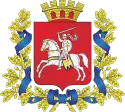Miory
| |
|---|---|
 | |
 Flag  Coat of arms | |
 Miory Location within Belarus | |
| Coordinates: 55°37′N 27°37′E / 55.617°N 27.617°E | |
| Country | Belarus |
| Region | Vitebsk Region |
| District | Miory District |
| First mentioned | 1514 |
| Population (2023)[1] | |
| • Total | 7,815 |
| Time zone | UTC+3 (MSK) |
| Postal code | 211287 |
| Area code | +375 2152 |
| License plate | 2 |
| Website | miory |
Miory or Myory (Belarusian: Мёры; Russian: Миоры; Lithuanian: Mėrai; Polish: Miory) is a town in Vitebsk Region, Belarus. It serves as the administrative center of Miory District.[1] As of 2023, it has a population of 7,815.[1]
History
The town was first mentioned in 1514.[2]
Miory was occupied by Soviet forces in September 1939. Following the German invasion of the Soviet Union on June 22, 1941, Soviet forces withdrew from the town, and local anti-Semites committed a pogrom against the town's Jewish population, killing the rabbi, Dov Bear Pianco, and his wife. German forces occupied the town on 3 July 1941.[3] For the next three years until 4 July 1944, Miory was occupied by Nazi Germany and administered as a part of Generalbezirk Weißruthenien of Reichskommissariat Ostland. A ghetto was set up in the town, and all Jews were kept imprisoned there. A judenrat was established, led by businessman Zvi Hersch Hellman. The Jews of Miory were later joined by other Jews, who sneaked into the ghetto after fleeing other nearby towns. Prior to the war, the town had been home to 500 Jews, most of them agricultural workers or craftsmen. In October 1941, some young Jews from the ghetto were arrested by German forces and sentenced to death for "conspiracy against the German government", but the judenrat was able to stay the execution.[3]
On 2 June 1942, Jews were ordered to gather in the square and were then taken into the forest in the direction of Krukówka village. The Germans killed 779 people in the forest. About 80 people, however managed to escape,[3] some of them going on to join a partisan group. The final liquidation of the ghetto in Miory took place in December 1942.[4] A monument was later built at the site of the 2 June massacre.[5]
 Monument erected where the massacre took place.
Monument erected where the massacre took place. Plaque at the monument in Russian (left) and Yiddish (right)
Plaque at the monument in Russian (left) and Yiddish (right)
References
- 1 2 3 "Численность населения на 1 января 2023 г. и среднегодовая численность населения за 2022 год по Республике Беларусь в разрезе областей, районов, городов, поселков городского типа". belsat.gov.by. Archived from the original on 17 April 2023. Retrieved 5 August 2023.
- ↑ "Miory Regional Executive Committee - History". www.miory.vitebsk-region.gov.by.
- 1 2 3 "מיורי (Miory) – האנציקלופדיה של הגטאות" [Encyclopedia of the Ghettos – Miory]. Yad Vashem (in Hebrew). Retrieved 2020-09-21.
- ↑ "History - Jewish community before 1989 - Miory - Virtual Shtetl". www.sztetl.org.pl. Archived from the original on 2016-08-12.
- ↑ "Мое местечко\Миоры". Archived from the original on 2016-05-30. Retrieved 2016-05-06.
